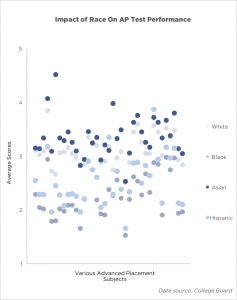Every so often, stories of promising young students who exhibit extraordinary academic talent sweep the Internet; when a Naperville North student became the first in the world to receive a perfect score on the AP Physics exam, he was featured in the Chicago Tribune. Stories like this however, while incredibly impressive and inspiring, often ignore the bleak reality facing the majority of students who take these exams. AP tests are graded on a scale of one to five, where scores three and above are considered passing – in 2016, the national average score for all Advanced Placement exams taken was a mere 2.85, a failing score.
Advanced Placement classes teach curriculum designed by the College Board, and are offered to high school students as college-preparatory classes. Following completion of the course, students may take an optional AP Exam to demonstrate their mastery of the course content, and potentially earn college credit. While AP classes are not the only way to provide advanced educational opportunities, participation in this curriculum provides a lens for analyzing educational quality.
One of the most concerning trends revealed by this data, is the disparity in performance of Black and Hispanic students compared to their White and Asian counterparts. Black and Hispanic students average scores of 2.03 and 2.41 respectively. In contrast, Asian and White students average scores of 3.05 and 3.02 respectively.

When looking at average scores on the 34 individual subject tests, as in the graph above, this trend is still evident. Across subjects in mathematics, the hard sciences, social sciences and humanities, Asian and White students consistently outperform Black and Hispanic students. The racial achievement gap is a well-documented one, a divide that has eluded the majority of efforts to address it. Nevertheless, it continues to perpetuate a cycle of disadvantages among minority communities.
Moreover, these trends continue to be troubling, not only because of the racial disparities highlighted by the data, but also because of the low scores overall. Among these four racial groups, only students who identified themselves as Asian or White averaged passing scores above a three, and even then, just barely. This calls into question the quality of preparation that schools are providing to students who choose to take AP tests. AP tests are supposed to teach advanced material, and if most students are failing, it’s an overwhelming red flag for the program’s implementations in high schools across the country.
Furthermore, AP tests are marketed to students as a way to avoid paying higher tuition costs in the future. Many colleges offer credit for certain scores on some AP exams; therefore, it can be economically beneficial to pay a comparatively small test fee now, and save the thousands of dollars in tuition that it would cost to take the college level equivalent in the future. Yet, this plan is contingent on at least earning passing scores, and in many cases higher scores of four or five are required for credit. When students are scoring so poorly on their AP exams, this bargain becomes questionable.
The fee for an AP exam is $93 per test, a cost that while occasionally subsidized, still presents a financial investment that is not guaranteed to pay off. Given that Black and Hispanic students already tend to come from lower income families than White and Asian students, and are also failing at higher rates as well, we should be asking ourselves whether the current education system is truly serving its students. It is time to reevaluate what schools can do to better educate all students seeking a college preparatory curriculum, to ensure that students taking Advanced Placement classes have truly mastered the content. Especially, schools must find ways provide equitable opportunity for Black and Hispanic students, who appear most disadvantaged under current systems.